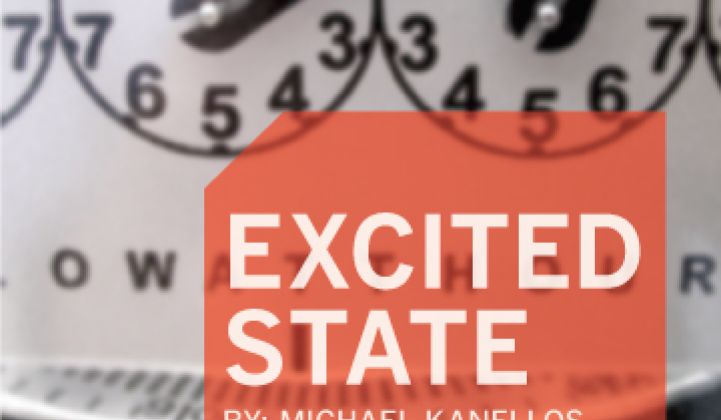Solazyme -- which produces fuel, food additives and chemicals from algae -- recently filed the preliminary paperwork for an IPO and soon will make the rounds on Wall Street to drum up interest in the offering.
The circumstances look good. Rising oil prices, tightened CAFE standards and global biofuel mandates are boosting demand for biofuels. Both Amyris and Gevo recently pulled off successful IPOs and both companies, right now, get the vast majority of their revenue from buying and reselling fuel from third parties.
Solazyme reported $37.1 million in revenue in 2010, mostly from its own products and technology. It has development deals with Chevron, the U.S. Navy, Sephora, Dow, Qantas, Honeywell UOP and Whole Foods, among others. It produced 455 metric tons of oil between January 2010 and February 2011.
The production process it has honed can produce fuel for $3.44 a gallon in a commercial-scale factory, which, ideally, can start to move toward reality after the $100 million IPO. In 2010, net losses came to $16.2 million, but losses have become par for the green-IPO course.
But there’s another factor that bodes well for the IPO that you won’t see listed in the S-1. It’s a factor that has -- and will likely continue -- to have an impact on the company’s trajectory.
And it places Solazyme into a rarefied club that includes Microsoft, Hewlett Packard, Intel, Yahoo, EnerNoc, Apple and Google.
The founders were friends before they got into business together.
CEO Jonathan Wolfson and CTO Harrison Dillon met as freshmen at Emory University in the late '80s. Wolfson went on to corporate law and Wall Street. Dillon got a PhD in genetics became an intellectual property attorney, but they joined forces to start Solazyme in 2003. Weirdly, they had talked about starting a company the first day they met, Wolfson and Dillon told me once.
While conventional wisdom says that friendship gets in the way of running a business, in the right circumstances, it can create an enduring level of trust and stability that is otherwise difficult to replicate. The CFO is not just the executive charged with overseeing corporate finance: he’s also someone that has picked up plastic cups at your apartment after a party and lied to the police on your behalf.
Look at Microsoft. Founders Bill Gates and Paul Allen knew each other in high school. Gates' Harvard classmate Steve Ballmer joined after a stint at Proctor & Gamble to become only the second CEO in company history. Tensions have existed between them, but Microsoft remains one of the most successful tech companies in history.
Hewlett and Packard worked for their entire careers at their eponymous company (except for Packard’s brief stint at the Nixon White House) and developed the HP Way, along with one of the largest electronics conglomerates in the world. Bill and Dave’s offices, along with their executive washroom, can actually still be seen at HP Labs headquarters: employees leave spare change in their desks.
Bob Noyce and Gordon Moore knew each other from Shockley Semiconductor and Fairchild before starting Intel in 1968. Moore, who also conducted research at UC Berkeley, dragged along one of his grad students. Andy Grove, the student, remarks that Moore is the only boss he’s ever had.
Tim Healy and David Brewster met at Tuck, the business school at Dartmouth, before stating EnerNoc. Although a success now, EnerNoc initially faced skepticism from VCs and had trouble getting funding. (You could also add Amyris to this list with an asterisk: the founders were conducting research together at UC Berkeley, but CEO John Melo comes from big oil. Meanwhile, Scuderi, Silver Spring Networks, Hycrete and Rivertop Renewables are father-son companies.)
In Solazyme’s case, the early hardships derived from their approach to algae. Dillon already concluded that growing algae in ponds would be uneconomical. Solazyme decided to grow algae instead by feeding it sugar and fermenting it. Sugar adds cost, and early algae investors flocked to pedigreed firms like the Harvard-MIT spin-out Greenfuel Technologies, which proposed growing algae with sunlight and free CO2.
Greenfuel burned through $70 million before leaving a crater. Solazyme has likely produced more algae fuel than any other startup.
If you want to dig a little deeper on this, you can see that most of these friendships began at universities, the melting pot of the white-collar world that plays an economic and social role that’s hard to overestimate in the U.S. There’s a reason parents put transparent window stickers advertising their kids' alma maters on their cars. Apple can be considered an exception: Wozniak and Jobs were five years apart and the company endured dramatic upheavals and changes in management in the first two decades. In all of the other companies, most of the founders stayed in high-level positions for quite a while.
Another shared characteristic: Gates, Yang, the Google lads, Filo, Moore, Noyce, and Hewlett and Packard all became prominent philanthropists. Again, Apple is the exception. While Wozniak has a record of donating, you won’t see Jobs’ name on research institutions or even during the “Thank You” credits on Nova or Antiques Roadshow.
There isn’t even a Jobs Memorial Drum Circle at Reed College.
So good luck, Solayzme. The Emory alumni club will soon be calling.



